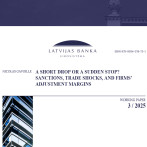A Recipe for Economic Growth – Ten Facts

Is there any action the government of Latvia could take to deliver growth of the Latvian economy as is the case with the German economy, but first catching up Lithuania and Estonia? If so, what exactly? If not, what about the "nature of Latvia" that makes it so?
Slightly paraphrasing the winner of the Nobel Prize in Economics Robert Lukas[1], the consequences for human welfare involved in questions like these are simply staggering: once one starts to think about them, it is hard to think about anything else.
The annual Latvijas Banka’s conference this year is dedicated to economic growth. Here are 10 facts about the factors that determine the economic growth process, whether economic growth is necessary, and why it is (un)likely to continue forever.
1.The basis of the economic growth process is a continuous increase in labour productivity.
The average income level in a country is the product of three components: the employment rate, workload and labour productivity. In other words, the income level in a country can be increased by having a larger part of the population working more hours or with higher productivity. It would not be wise to increase labour intensity – on the contrary, it has been gradually decreasing over recent decades, since higher income boosts the demand for leisure time. The employment level also has its own ceiling – although there are still internal labour reserves in Latvia, the historically low unemployment rate indicates that this ceiling is closer than ever before. Therefore, to achieve sustainable income growth, labour productivity growth is essential. The winner of Nobel Prize in Economics Paul Krugman put it this way: "Productivity is not everything, but in the long run it is almost everything"[2].
2. Economic growth is a relatively new phenomenon.
Sustained income growth began about 250 years ago with the industrial revolution, which made it possible to radically increase the labour productivity trend. Before that, relatively "fat" years were usually followed by "lean" years (or even "lean" centuries, for example, the European Middle Ages) without a trend of sustained income growth.
Economists have long refused to believe that sustained income growth is possible at all. For example, Thomas Malthus predicted 220 years ago that humans would always live with an income level that barely exceeds the subsistence level[3]. Karl Marx, on the other hand, focused on the struggle between the employer and the employee for their share of "added value" or "pie", ignoring the situation when, with the constructive cooperation of economic agents, the total "pie" grows over time, making both of them better off. Although in Karl Marx’s time (mid-19th century) economic growth was already in full swing, apparently it could not be seen from the window of the London Library and without access to accurate statistics. The concept of "gross domestic product", which is nowadays the main indicator of the economic growth process, only appeared shortly before World War II.
3. The most promising tool for promoting economic growth is institutions.
Digging ditches with excavators and tractors is more productive than with a shovel or by hand – even such a simplistic example reflects the role of production equipment, education and technology in raising labour productivity. However, the fact that it is necessary to invest and study is included in any textbook on economic growth. So why don’t poor countries invest and study more?
Some say this is because they have a different climate[4]. And indeed, the income level in temperate climate countries tends to be much higher than in the tropical climate zone. Others emphasize the impact of differences in culture, religion or traditions on characteristics of society such as individualism, risk-taking, and tolerance. For example, Max Weber noted that Protestantism emphasizes the importance of work, thrift, and savings, in contrast to other religions valuing material wealth as a success indicator – these could have been important economic growth foundations in Western European countries.
But how to explain, for instance, the rapid economic growth of South Korea after World War II, compared to North Korea? These countries had a common history, culture, traditions, and even today have a common climate. Some emphasize the role of national leaders (for example, in the economic development of Singapore or China), but the impact is not in the personalities of the leaders themselves, but in how they act. This is most accurately described by the word “institutions” or “rules of the game” in society. For example, countries that reward creativity and innovation from school age are more likely to develop faster than those that punish pupils for every deviation from a textbook. For Latvia, a more understandable example could be the case of competition restrictions on university professor vacancies, which can negatively affect the quality of education, slowing down the development of human capital and, consequently, economic growth.
This does not rule out the impact of other specific factors on well-being[5]. However, it is the significant and universal influence of institutions on economic growth that gives countries hope to overcome their backwardness, if they cannot change the geographical location, culture or climate. A 2018 study by Latvijas Banka and the European Central Bank shows that by implementing the best institutional practices across the European Union (EU) countries, the pace of economic growth can be accelerated by almost one percentage point per year.
4. "Economic growth" means taking one small step every day.
Some people may find it modest to add one percentage point per year to economic growth by successfully implementing a wide range of structural reforms – from reducing bureaucracy and crime to improving the quality of education, healthcare, and investor protection. For instance, if the Latvian economy grew one percentage point faster than the economy of Lithuania and Estonia, we would reach the income level of our neighbouring countries only in 2040. This example also shows well that it is impossible to become the economic leader of the Baltics in five years, simply by changing the tax rates by a few percentage points.
One small step every day in the long term – this is what the economic growth process looks like. Each daily step seems insignificant on its own, but accumulating over a long period of time, this is how income gaps between countries are formed or reduced. For example, the economic growth rate of 2.0% per year increases GDP 7.2 times in 100 years, while the economic growth rate of 2.5% per year would increase it 11.8 times. No "gas to the floor" policy can achieve such a sustainable long-term impact[6].
5. Countries can become rich only by continuously developing over a long period of time.
Examples of how a fishing village turned into a global financial centre in one generation (Singapore) or the promising Rhodesia turned into a country mired in hyperinflation (Zimbabwe) are truly fascinating. However, these are rare exceptions. Nowadays, the rich are mostly the same countries that were rich even half a century ago. On the other hand, most of the countries that were poor are unfortunately still poor.
This should be remembered when reading the "sudden outrage" in the media that Latvia "still" ranks fourth from the bottom among EU Member States in terms of average income level (after Bulgaria, Greece, and Slovakia). In fact, the development of the Latvian economy is significant – over the past 30 years, the average income level in the country has grown three times faster than the EU average. In the mid-1990s, we were almost three times poorer than Greece – now, in terms of income level, we are slightly ahead of it. The fact that Lithuania and Estonia – the countries with a similar climate, history, and culture – are ahead of us in terms of income by about seven years shows what our development potential is. Unfortunately, it is not yet fully utilized.
6. In the process of economic growth, countries are not competitors but allies.
Wealthy Lithuania or Estonia does not take anything away from Latvia. On the contrary, the richer our main trading partners are, the more they import, including Latvian products, the better for our exports and the economy. Wealthy and happy neighbours create a better environment – they don't threaten us in the stairwell or try to steal the doormat. For these reasons, it is also in the interest of Lithuania and Estonia to have a more prosperous Latvia.
With the slogan "catch up with Lithuania and Estonia", we do not want not become the first in the village by any means, but rather to understand the factors of success of our neighbours. Just as the example of a training partner can encourage us to do more push-ups, Lithuania, Estonia, Germany or the Nordic countries provide great examples from which we can learn. Latvia is part of European civilization, so its prosperity is not imaginable during the European decline. Latvia's development should strengthen Europe, not happen at the expense of Europe.
7. Economic growth affects small and large countries equally.
Among the rich are countries with large (USA, Japan) and small populations (Iceland, Liechtenstein). Similarly, poor countries can be both small (Tuvalu, Tonga) and large (Ethiopia, Nigeria). For example, Nigeria has 100 times more people than Latvia, but they are on average 7 times poorer. In Finland, Norway, Denmark, Ireland, or New Zealand, there are as many people as in Lebanon or Congo (about 5-6 million), but the standard of living between these two groups of countries varies several times.
The income level or its growth rate has no relation to the population size of a country[7]. This fact disproves the myth that economic growth is supposedly impossible in a "half-empty country", with the latter being understood as Latvia. In fact, the population density in Latvia is not smaller than that of Estonia or the United States, we have three times more people than in Luxembourg, but the territory of Latvia is larger than, for example, that of Belgium, Slovenia, or Israel - this did not prevent all of the above-mentioned countries from achieving a higher standard of living.
8. Economic growth no longer means a cult of consumption and environmental degradation.
The main goal of a country is to maximize the self-realization of each member of society. However, we can start thinking about self-realization only when we have enough food to eat. Some totalitarian regimes and utopians have tried to turn Maslow's pyramid upside down, though unsuccessfully. Long-lasting ignorance of human material needs, with the collapse of the regime, opens up draconian forms of thirst for profit and crime, which we experienced in Latvia in the 1990s. For no one else consumption is so important as for the person who cannot afford it. Therefore, it is not for nothing that the tendency to voluntarily reduce consumption (post-consumer society) is most often observed in developed countries rather than in those that deny or ignore human material needs. On a global scale, there is a close positive correlation between the income level in a country and the healthy life expectancy in it. Therefore, higher income means greater opportunities for self-realization or at least more time for self-realization.
Economic growth in its early phase (with industry becoming the main sector instead of agriculture) led to environmental pollution. However, as income levels rise, people increasingly value intangible goods, one of which is a clean and healthy environment. Therefore, in the next phase of economic growth, with penalties for polluters increasing and services becoming the main sector, a higher income level means lower pollution. For example, the cities with the highest air pollution are located in India, but they are also relatively poor. The positive impact of income level growth on the environment is also visible over time – it is enough to compare today's London with the scenes from Charles Dickens' novels.
9. Economic growth may not last forever.
If Latvia's average income level grows by 4% per year, after 100 years the average income per person in the country would be one million euro per year. Is the annual average income of one million euro achievable? Perhaps not. However, even Latvia's current GDP per capita (€21,000 per year) would probably seem like an unreal number to our 19th century ancestors, if this number were converted into goods units they understood.
Similarly to how the end of the world has been predicted several times, not only in the Middle Ages, but even before our era, so economists have been regularly predicting the end of economic growth for several decades. Some people think that economic growth will stop when oil runs out. However, it is precisely technological progress that allows us to extract oil from hard-to-reach layers, use this resource more efficiently, and also develop alternative energy sources. Others are scared that the planet will not be able to feed more than "X billion" people; but thanks to technological progress, this number "X" is constantly increasing. Someone else says that "everything that scientists could discover has already been discovered, and everything that could be built has already been built", but at the beginning of the 20th century, some economists thought the same, admiring the invention of the radio or the development of railway infrastructure.
10. Economic growth is not a main aim, but a tool.
Economic growth may end someday, but it is unlikely to be because "oil will run out". Most likely, it will happen when people at some point get tired of the demands to constantly increase their productivity and instead consciously choose to do less and slower, but with more satisfaction. Technically, this would mean that the GDP growth rate slows down and approaches zero, but in reality, this choice can make people happier, especially in countries where people are already suffering from overwork (Japan, South Korea). In this case, it would be important for the governments to properly understand the reasons behind the economic slowdown and not to try to stimulate the GDP growth rate at any cost.
Conclusion
The end of economic growth does not mean the end of the world. The idea of a country as a giant factory that must produce hundreds of tons of steel, build thousands of cultural centres and achieve a certain increase in output over the previous year is gradually becoming obsolete. As this idea fades, so does the role of GDP in measuring well-being. If something else makes people happy – health, love, safety, a clean environment, or free time – it is a value itself, even if it is not reflected in the economic growth rate.
This global shift in thinking was discussed at Latvijas Banka's annual economic conference held on 8 November 2023 in Riga. The event brought together a number of world-renowned leaders in economic thought. Watch the recording of the conference on Latvijas Banka's YouTube channel.
[1] Robert Lukas (1988). "On the Mechanics of Economic Development."
[2] Paul Krugman. "The Age of Diminished Expectations" (1994).
[3] Any food surplus (as agricultural productivity improves) will be followed by population growth that will eat up that food surplus. As a result, the average income level brings back close to the subsistence level.
[4] The beginnings of the idea about an important role of climate can be found in the 1748 book "The Spirit of the Laws" by the French philosopher Montesquieu: "The heat of the climate can be so excessive that the body there will be absolutely without strength. So, prostration will pass even to the spirit; no curiosity, no noble enterprise, no generous sentiment; inclinations will all be passive there; laziness there will be happiness." […] "People are […] more vigorous in cold climates. The inhabitants of warm countries are, like old men, timorous; the people in cold countries are, like young men, brave."
[5] For example, economic growth can be slowed down even by "unsuccessful" national borders – winding, with enclaves (for example, as in Tajikistan or Armenia) or on the contrary – too straight and arbitrarily determined by geographical latitude (as in several African countries). They force countries to maintain military tension for a long time, at the expense of reducing investment in education, healthcare and social protection. Another example is that the spread of epidemics in Africa can reduce the return on investment in education, making these investments economically unprofitable.
[6] "Gas to the floor" or giving money to people (for various reasons) to meet short-term consumption needs can increase popularity (that's why politicians like this policy) and increase the gross domestic product by as much as 10% within one year. However, the long-term consequences of the "gas in the floor" policy are usually only higher prices (not higher welfare).
[7] Different economic growth theories offer different explanations for how population can affect income level. Models that focus on the importance of natural resources emphasize the negative impact of population on income. On the other hand, models that focus on the process of creating new ideas (or endogenous technical progress) emphasize a positive effect of population on income. These effects are likely to offset each other; in addition, income levels are determined by other factors independent of population, such as institutions. Therefore, in the real world, there is no correlation between the population of a country and its income level.
Textual error
«… …»






